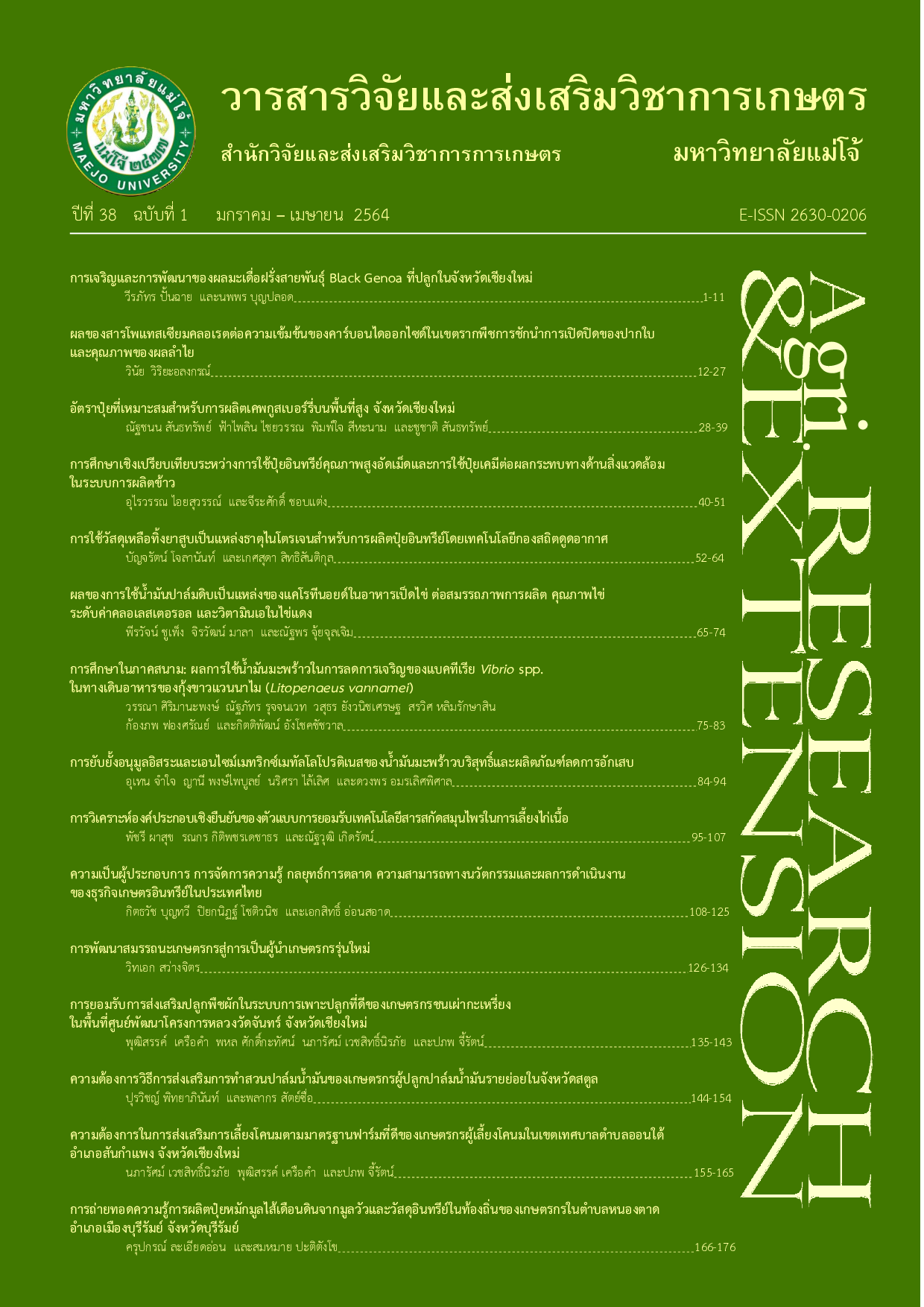การถ่ายทอดความรู้การผลิตปุ๋ยหมักมูลไส้เดือนดินจากมูลวัวและวัสดุอินทรีย์ในท้องถิ่น ของเกษตรกรในตำบลหนองตาด อำเภอเมืองบุรีรัมย์ จังหวัดบุรีรัมย์
คำสำคัญ:
ปุ๋ยหมักมูลไส้เดือนดิน, วัสดุอินทรีย์, มูลวัวบทคัดย่อ
การถ่ายทอดความรู้การผลิตปุ๋ยหมักมูลไส้เดือนดินจากมูลวัวและวัสดุอินทรีย์ของเกษตรกร ในตำบลหนองตาด อำเภอเมืองบุรีรัมย์ จังหวัดบุรีรัมย์ เป็นการวิจัยเชิงปฏิบัติการแบบมีส่วนร่วม โดยเครื่องมือที่ใช้ คือ การสัมภาษณ์ แบบสอบถาม กลุ่มตัวอย่าง และผู้ให้ข้อมูลสำคัญ คือ ตัวแทนเกษตรกรที่เข้าร่วมโครงการ วิเคราะห์ข้อมูลโดยการวิเคราะห์เนื้อหา วิเคราะห์สรุปแบบอุปนัยและสถิติพื้นฐาน กระบวนการถ่ายทอดการผลิตมีสามขั้นตอน คือ ขั้นความรู้การจูงใจ ขั้นไตร่ตรองตัดสินใจ และขั้นทดลองปฏิบัติการผลิตปุ๋ยหมักมูลไส้เดือนดิน ซึ่งมีเกษตรกรเข้าร่วมครบทั้งสองครั้งจำนวน 18 คน เมื่อทดลองเสร็จแล้วนำผลไปวิเคราะห์องค์ประกอบทางเคมีในห้องปฏิบัติการ เพื่อนำมาเสนอต่อกลุ่มเกษตรกร โดยก่อนการอบรมและหลังอบรมมีการเก็บข้อมูลเกี่ยวกับความคาดหวังและความพึงพอใจ พบว่าก่อนอบรมมีความคาดหวังส่วนใหญ่ในระดับปานกลางคิดเป็นร้อยละ 55.55 หลังอบรมมีความคาดหวังในระดับสูงคิดเป็นร้อยละ 83.33 ส่วนความพึงพอใจเฉลี่ยโดยรวมก่อนอบรมอยู่ในระดับปานกลาง (x ̅=3.45) และหลังอบรมอยู่ในระดับมากที่สุด (x ̅=4.42) ซึ่งเป็นกระบวนการที่ทำให้เกษตรกรเกิดการยอมรับในองค์ความรู้และก่อให้เกิดความยั่งยืนในการพัฒนาชุมชนท้องถิ่นให้เข้มแข็งได้ต่อไป
เอกสารอ้างอิง
Agarwal, R. and j. Prasad. 1999. Are Individual differences germane to the acceptance of new information technologies. Decision Sciences 30(2): 361-391.
Aizstraula, D., E. Ginter and M.A.P. Eroles. 2015. Appling theory of diffusion of innovation to evaluate technology acceptance and Sustainability. Procedia Computer Science 43: 69-77.
Arreluk, S. and S. Sanusan. 2014. Effect of a vermicomposts from earthworms on changes of soil physical properties and improve soil structure. 49 p. In Research Report. Chiang Mai: Maejo University. [in Thai]
Davis, F.D. and V.A. Venkatesh. 1996. Critical assessment of potential measurement biases in the technology acceptance model: tree experiments. International Journal of Human-Computer Studies. 45(1): 19-45.
Hornback, K. and M. Hertzum. 2007. Technology acceptance and user experience: a review of the experiential component in HCL. ACM Transaction on Computer-Human Interaction. 24(5): 33.
Hunnark, C., S. Plianbangyang and W. Atavadachanyut. 2017. Strengthening community development through the knowledge management process in organic farming in Nakhon Pathom province, academic services. Journal Prince of Songkla University 28(2): 158-166. [in thai]
Kanchanakarun, J. 2013. A study of technology transfer process for producing granule organic fertilizer from local materials in community. Rajamangala University of Technology Phra Nakorn Research Journal 7(2): 47-61. [in thai]
Kanchanakarun, J. and W. Wongchaya. 2010. Adoption of agricultural innovation and technology in Yonglae village community. Rajamangala University of Technology Phra Nakorn Research Journal 4(1): 92-101. [in thai]
Kelman, H.C. 1958. Compliance identification and internalization: tree process of attitude change. Journal of Conflict Resolution 2(1): 51-60.
Koul, S. and A. Eydgahi. 2018. Utilization technology acceptance model (TAM) for driverless car technology adoption. Journal of Technology Management and Innovation 13(4): 37-46.
Manivannon, S., M. Balamurugan, K. Parthasarathi, G. Gunasekaran and L.S. Rangganathan. 2009. Effect of vermicompost on soil fertility and crop productivity bean (Phaseolus vulgaris). Journal Environment Biology 30: 275-281.
Mikhama, K., L. Manmart and S. Simaraks. 2012. Learning process and knowledge creation of para-rubber farmers. Khon Kean Research Journal 12(2): 128-139.
Planing, P. 2015. Measuring consumer Innovativeness: an empirical re–evaluation of Roger’s innovativeness Scale. International Journal of Scale, Retailing and Marketing 4(2): 86-96.
Rogers, E.M. 1995. Diffusion of Innovations. 4thed. New York: The Free Press. 518 p.
Venkatest, V. 1999. Creation of favorable user perceptions: exploring the role of instrinsic motivation. MIS Quarterly 23(2): 239-260.
Watcharakiettisak, T. 2016. Community economic strengthening by developing community enterprise group at Tambon-Polsongkram administration organization, Nongsung district Nakhonratchasima province. Academic Business Journal 5(1): 43-54. [in Thai]
Wijitkosom, S. and U. Leknoi. 2017. Transfer process technology and innovation of research to utilization area base. Environmental Journal 21(3): 19-28. [in Thai]
ดาวน์โหลด
เผยแพร่แล้ว
รูปแบบการอ้างอิง
ฉบับ
ประเภทบทความ
สัญญาอนุญาต
บทความนี้ได้รับการเผยแพร่ภายใต้สัญญาอนุญาต Creative Commons Attribution-NonCommercial-NoDerivatives 4.0 International (CC BY-NC-ND 4.0) ซึ่งอนุญาตให้ผู้อื่นสามารถแชร์บทความได้โดยให้เครดิตผู้เขียนและห้ามนำไปใช้เพื่อการค้าหรือดัดแปลง หากต้องการใช้งานซ้ำในลักษณะอื่น ๆ หรือการเผยแพร่ซ้ำ จำเป็นต้องได้รับอนุญาตจากวารสาร





